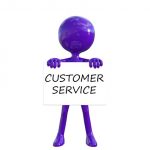 By Anabelle Leland
By Anabelle Leland
After a long stretch of pursuing sales, answering calls and placing orders for new products, you realize your small business is experiencing a common growing pain—you have a large amount of customer interest but not enough resources to meet those demands.
Having “too much” business is one of the better problems that your business could be facing. However, without enough staff and tools to carry out this new workload, you’ll find it nearly impossible to continue growing your business without spreading yourself too thin and leaving customers disappointed with their experience.
To help you balance gaining new customers and keeping old ones, here are a few solutions to implement into your small business to stay on track.
Manage customer inquiries with new tech
Up and coming technology has had a major impact on the way everyone conducts business, and small businesses are no exception. As your organization grows, take advantage of new communication technology to help you and your team adequately respond to every customer request.
Responding quickly is perhaps the foundation of great customer service, but leaving prompt responses to customer emails is particularly challenging if your inbox is constantly flooded with new messaging. Add in spam, irrelevant messaging and multiple conversations (all at different points in the conversion process) and your inbox will rarely stay organized. Designed to streamline communication and reduce messages lost in hectic inboxes, email management software is one new piece of tech that has optimized the way small businesses handle their email. With a number of software options available, you can find a tool customizes to your desired workspace and integrates with other applications you already use.
While handling your emails is one challenge, customer phone calls are an entirely different beast. Call volume fluctuates throughout the day, and unlike emails, phones require an immediate response. Cloud contact centers are one integration that can help you manage calls between team members, respond to voicemail messaging and handle both outbound and inbound calls. And with technology specific to the needs of small businesses, contact centers help SMB owners assign new customers to specific agents, which establishes a personal connection and facilitates faster response times.
Start email marketing with a newsletter
If you have a product or service that consumers care about, they will be invested in the future of your business. Sending a monthly email newsletter is a simple strategy to help you share recent updates about your business and better connect with a relevant, highly engaged audience.
Treat your newsletter as a central hub of information that your customers can easily access. You should include links to your new products, personnel changes, recent news articles about your company, and buttons for each of your social media accounts. By making this information readily available, current and potential customers will be further enticed to engage with your online presence. As an extra boost to the user’s experience, your content team can include a brief FAQ section at the end of each update; this can also cut down on the number of calls and emails you receive.
For growing businesses, newsletters are particularly effective because they require the same amount of work, regardless of audience size. This means that your team can open up more time in their schedules to accomplish more tasks and focus on boosting their productivity.
Organize customer information
Businesses with smaller customer bases might be able to get away with a disjointed strategy for storing customer information. However, as your numbers increase, disorganization will lead to confusion and miscommunication that could jeopardize relationships you’ve built with customers.
Fortunately, small businesses today have resources designed to store, protect and manage customer information at a company-wide level to ensure everyone’s on the same page. Customer Relationship Management tools—referred to as CRMs—are an essential resource for businesses who need to track their prospects and quickly access customer information during phone calls. It may also be worth looking into a cloud-based CRM if your sales team is growing for each project too. Since the cloud instantly updates any and all changes to your database, this tech will ensure that your entire team has the most up-to-date information possible, whether they’re in the office or making sales on the road.
If you don’t have the resources for another monthly expense, a CRM spreadsheet template is an inexpensive method to start keeping track of customers. Whatever tactic you decide is best for your business, the most important piece of the puzzle is that you clearly communicate your plan of action across the company. The larger your business grows, the more important having a unified vision will be.
___________
Anabelle Leland is a digital content expert who is constantly researching and writing on upcoming trends in tech and company culture. Currently, she is particularly interested in the ways that these trends directly affect small- to medium-sized businesses and the larger business ecosystem.
